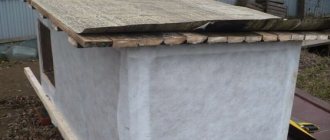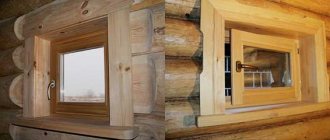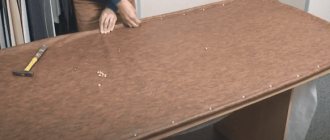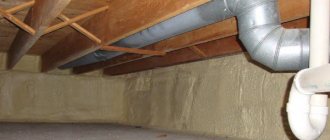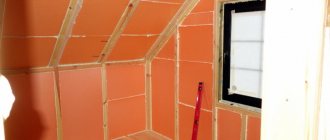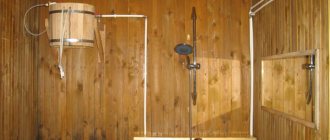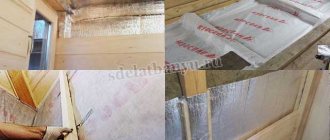How to insulate windows for the winter - protect yourself from the cold
With the onset of the cold season, the problem of heat conservation becomes very urgent, especially in houses and apartments where there are old window structures.
In fact, by completing a simple list of work, you can significantly reduce heat loss. In this article we will look at how to insulate windows for the winter with your own hands and what basic materials will be required for this. Naturally, the question of how to insulate old windows for the winter is much more common than how to thermally insulate new structures made of wood or PVC. But, nevertheless, even recently installed window units require inspection for tightness. Many people underestimate the real benefits of window insulation, but they are very, very great.
Insulation using film
The reason for the cold in an apartment or house may be that warm air cools when it comes into contact with cold glass, especially if the glazing area is large enough. This happens when the house has very large windows or there is a loggia attached to the living room.
In this case, insulating the loggia will be more effective if you cover the glass with heat-saving film. It has the ability to reflect most of the infrared radiation, while practically not blocking sunlight and improving sound insulation.
The film is glued directly to the glass with the side that has a metallic sheen
We insulate old windows
In fact, there are a lot of methods, and every homeowner can tell you an original one using simple improvised means. Among them there is temporary protection, which is removed with the onset of warm weather, and there are also those that seal the windows for several years. Below we will tell you how to insulate windows with your own hands in the simplest ways.
Paper tape for gluing on wooden windows
Newspapers and paper strips
The method has survived many generations, but has not yet lost its relevance. Its price is very low, since old newspapers and strips of paper are used for the work. The first ones were soaked in water until a liquid mass was obtained, with which the cracks were sealed, and the second ones glued it all together. Usually, laundry soap was used as glue, which was diluted to a liquid consistency and applied to the strips. All the “beauty” lasted only until spring, when it had to be mercilessly torn away from the windows. It was here that the negative side of the method manifested itself, when along with the “insulation” the paint peeled off, which caused additional trouble.
Handy means for window insulation
Wool and strips of fabric
The previous method has been transformed into a more advanced one. Now cotton wool was stuffed into the cracks, which was sealed on top with a cloth, just as in the first case. Thanks to the air bubbles in the cotton wool, the thermal insulation was somewhat better. In addition, and this is important, it could be easily removed, and there were no traces left from the fabric strips. Today, you can replace fabric with masking tape, which costs very little. Although the method is primitive, it should not be discounted.
We use tape and foam rubber
Do-it-yourself insulation of windows with foam rubber occurs when cotton wool does not help. Usually it is fixed in places where the wooden sashes do not fit tightly to the frame. It is glued around the perimeter to ensure the tightness of the window.
Advice:
On the construction market, purchase foam rubber that has a special adhesive surface so as not to nail it to the frame with nails.
The service life of such insulation does not exceed three years, after which the material begins to deteriorate and fail to perform its functions. You need to stick paper tape over the frame, which you remove in the spring, leaving the foam rubber in place.
other methods
- Sealing cracks with paraffin is used for small cracks in frames . The material must be melted and drawn into a syringe, with which to fill the defects of wooden windows. If they are large, use a cord or clothesline, which you push into the crack and fill with paraffin. In this case, this will be enough for several seasons.
- Swedish technology has become popular recently and, as it turns out, it was not invented by the Swedes at all. The method began to be called thanks to the EuroStrip material, which was actually invented in Sweden. The method is called “groove window sealing technology”.
Application of Swedish technology If you use it, then you can freely open the window sashes in winter, since they do not need to be sealed, and the “insulation” will last more than 15 years. In this case, there is a partial reconstruction of wooden windows, and not just protection “for the season.”
- The use of sealant is indicated when sealing small gaps between glass and glazing beads, as well as in frames . Before this, the windows are washed and dried, and sealant is applied only in the temperature range of +5-40 ° C. Prepare a construction gun for work and place a tube with the substance in it, having previously cut off the “nose” on it along the line. You will be able to apply the material to the most difficult to reach places.
Window tape
Window tape acts on the principle of putty, that is, it temporarily closes existing cracks, preventing cold air from entering. However, this method is much less effective, since the adhesive tape has almost zero thermal insulation value. Therefore, if you decide to insulate the windows with tape, then first fill the cracks with cotton wool, tow or other similar material. And only after that stick the tape. Such insulation will be much more effective.
The disadvantages of insulating windows with tape are as follows:
There is only one plus - low cost, the necessary materials will cost very little. Putty and tape also have one common drawback - if you seal the gap between closed doors, you will no longer be able to open them for ventilation.
Cotton wool or foam rubber for windows
Technical wool is cheaper, but it is sold in large quantities.
Using cotton wool or foam rubber, you can seal large gaps, for example, between window sashes or a sash and a wall or window sill. The cotton wool/foam rubber must be sealed on top with paper tape or special tape, because It is difficult to seal small cracks with cotton wool. In this case, the paper tape will serve not only a decorative function, but also increase the efficiency of insulation.
Average cost : cotton wool (50 rubles/200 g), foam rubber (30-35 rubles/skein).
Advantage : simplicity and lack of wet work.
Disadvantages : the cost of insulation increases (+ the price of cotton wool or foam rubber), additional finishing of the insulated seam is required. In addition: cotton wool and foam rubber absorb moisture, the work must be repeated annually, and a sealed window cannot be opened for ventilation.
How to cover windows with newspaper for the winter - video
Insulation of wooden windows for the winter from the outside
External insulation is carried out from the outside of the window, from the street. It is much easier to carry out this type of work in a private house than in a multi-storey one. However, in the apartment and in the house, the following options are available:
Insulation of window slopes from the outside
Thermal insulation of window slopes is a mandatory step, since insulation from the inside does not exclude the possibility of heat loss from the street. Polyurethane foam or rigid insulation is used as insulation.
Insulation of window slopes from the street
How to insulate slopes from the street:
- inspect the window around the perimeter of the frame, remove all elements that do not adhere well (old putty, polyurethane foam, insulation, plaster, paint, etc.);
- prime the surface of the slopes;
- Blow out all the cracks with polyurethane foam and/or glue the foam onto the slope. During the installation of foam plastic, you need to ensure that the sheet fits onto the frame;
- if only foam was used, it must be cut off after complete hardening and sealed with plaster. If polystyrene foam was used, it must be covered with a polymer mesh, perforated tape installed in the corners and the slope plastered;
- After the plaster has completely dried, the slope is primed and painted.
Window insulation
Low tide is the lower part of the slope. Here it is recommended to fill all the cracks with polyurethane foam and install a drip strip on top. It is necessary to provide the opportunity to drain water downwards (the ebb strip is installed at an angle), turn the side edges up to avoid water flowing in, move the strip 20-30 mm beyond the edge of the masonry, and seal all joints between the strip and the slope or frame with sealant.
Eliminating cracks
Do not forget that wood is a breathable and non-hygroscopic material, so the outside of the window must be painted or varnished.
Insulation of window openings
This is one of the most important points. Half-arm gaps between the slope or window sill and the frame, as builders often leave, are not always noticeable.
- The most common way to insulate such cracks is to fill them with foam. Indeed, there is little hassle. But after drying, you need to cut off the excess and seal this “beauty” with paper tape.
- To seal the cracks, you can use self-prepared putty. Take building plaster and chalk, mix them in proportions 2/1, adding a little water. Treat the cracks with this putty, and in this case the color will not stand out much against the background of the frame.
Using bubble wrap
Bubble film for window insulation may not be so popular due to its external visibility, but it can serve as high-quality and fairly cheap insulation. Such a film may have a smooth surface or be covered with bubbles on both sides. The film that is used as packaging is suitable for the work. Due to the air content in the bubbles, the product attached to the window does not allow heat to escape through the glass so quickly and retains up to 20% of the heat in the room. The disadvantages of this film include its high density. Light will enter the room, but in much less quantity.
Heat-saving film
If all the cracks are closed, but the window is still a source of heat loss, it means that heat is leaving through the glass. Heat-saving film is a modern material specifically designed for insulating windows. It comes in two types: glued to the glass itself or attached to the frame using double-sided tape. Its additional advantage is that it practically does not absorb light and does not interfere with its penetration.
The heat-saving film consists of several layers, the main one of which is metal. The heat inside the room, reflected from it, remains in the room, while ordinary glass allows it to pass through.
Source
Overview of the main problems and how to fix them
To understand how metal-plastic windows are insulated, you need to figure out which places require special attention:
- All the junctions of the sashes on the frame - it’s easy to check them, you need to slowly move your hand along the connection; if there is a problem somewhere, you will immediately feel it.
- You should also check whether there is any blowing from under the glass unit; the procedure is similar to the point above.
- Particular attention is required to checking slopes and window sills, both indoors and outdoors.
Doors
For many, the concept of insulating plastic windows is associated precisely with eliminating problems at the junction of the sash and frame.
And if you also have problems with this part of the window, then you need to carry out the following work:
- The problem may be incorrect adjustment of the system; there are holes in the top and bottom of the sash designed for this . If you have at least minimal skills, you can adjust the position of the sash with your own hands, but if you do not understand how the work is carried out, it is better to invite a specialist - this service will not cost much, plus it comes with a guarantee.
- If the system is adjusted well, but it still blows from under the sash, then most likely the culprit is the insulation for plastic windows or, as it is also called, the sealing profile . From frequent opening and closing, its properties may deteriorate, and the seal will not be of high quality; only replacing this element will help. Thermoplastic has proven itself well - a new development, characterized by the highest performance indicators.
For the best gluing, a special pressure roller is often used, as in the photo
Advice! If you need to replace the sealing elements, do not forget that the old ones must be removed carefully, and all adhesive residues from the surface must be carefully removed using alcohol or a special cleaner for plastic.
To ensure additional compaction, it is necessary to turn the bosses to the “winter” position, since in 90% of houses they are always installed in “summer”.
Slopes and window sills
Temperatures can drop greatly through this part of the system. Most often, problems are caused by a violation of installation technology or improper finishing.
The nature of the necessary work depends on the specific case, most often the following activities are required:
- If the slopes are covered with plastic or other decorative elements, then they must be removed and the condition of the insulation checked. Most often, it is necessary to remove the remains of the old material and lay in a new one, this can be either polystyrene foam or polyurethane foam - with its help you can fill even fairly large cavities, while the composition has very high insulating properties.
- If the mounting foam was not sealed with plaster or cement mortar on the outside, then under ultraviolet radiation, after a few months, the process of destruction of the structure will begin, and after a year or two, cold air will penetrate into the room. Depending on the extent of the damage, it may be necessary to remove the old material and re-process it, or plaster the slopes.
Insulation of window openings
When installing metal-plastic or wooden windows, it is necessary to insulate not only the window frames themselves, but also the entire area of the window opening , and work should be carried out both from the outside and from the inside.
External thermal insulation is carried out using a special sealant - it is intended for street work and is able to fill all the gaps formed during installation, also protecting the mounting foam from adverse effects.
Mineral wool or expanded polystyrene can also serve as a thermal insulator. These materials are quite cheap, but at the same time provide a high-quality thermal layer and tightness.
Keep in mind that windows that are insulated from the outside are additionally protected from the cold.
Insulation of slopes
Insulation of slopes can be carried out with various materials - sandwich panels, plasterboard or polystyrene foam. The most popular materials are gypsum and polystyrene foam - they are budget-friendly and quite suitable for doing the work yourself.
The process of insulating slopes with plasterboard is as follows:
- gypsum blanks of the required sizes are prepared - they are cut out and treated with a moisture-resistant primer, after which they must dry,
— starting from the side slopes, the workpieces are inserted into the slots,
— a gap is created between the plasterboard sheet and the wall, which is filled with polyurethane foam and temporarily taped with tape (painting tape),
— the upper slope is securely fixed with a beam resting on the window sill,
- after the foam has hardened, the timber and tape are removed,
— the resulting slopes are primed and painted.
Tip: A plastic profile is attached around the perimeter of the window opening to match the color of the wallpaper. The seam between the gypsum material and the window is securely sealed with sealant.
An example of how you can insulate windows from the outside using polystyrene foam and its subsequent plastering.
Insulation with polystyrene foam can also be done by you yourself. All work here comes down to gluing the thermal insulation boards completely to the outer wall surface . For such insulation you will need both the foam itself and the adhesive solution, as well as plaster and reinforced fiberglass mesh.
The work process in this case is as follows:
- foam plastic is glued to the slope from the outside,
- all resulting cracks are filled with an adhesive solution,
- the surface of the foam is completely covered with reinforced mesh,
- the resulting structure is plastered.
The foam can be secured together with special plastic connectors. This will make the structure more reliable.
How to insulate a window sill
We insulate the window sill before installing it with polystyrene foam and polyurethane foam.
The window sill of a plastic window may also need insulation. For these purposes, standard materials are suitable - polystyrene foam or mineral wool. It is advisable to carry out insulation work before installing the window sill - you can lay the foam in advance and glue it with foam. After installation, all gaps are also treated with foam.
If the window sill is already installed, then you need to identify all the existing cracks and treat them with silicone or other sealant suitable for outdoor work.
The above recommendations will allow you to enjoy the view from the window without feeling the cold. It is important that all work will require a minimum of costs from you - after all, you can carry it out yourself.
Why is it blowing from the window?
In most cases, either old wooden windows or single-chamber non-energy-efficient plastic windows let in the cold in winter. It also blows through the window sill because the sash does not fit tightly. You can radically solve the problem and increase the energy efficiency of the room by replacing the window with a two-chamber energy-saving one (with two, filling the chambers with argon and a warm spacer frame). But this is not a cheap option, although now in Ukraine it is possible to replace windows with “warm” ones with 35% compensation under the European IQ energy program. Plus, an energy-saving window will lose 2-3 times less energy in winter. But if for some reason the purchase of a new window is postponed, there are quite effective temporary measures.
The method of insulating wooden windows for the winter has been known for a long time: foam rubber + tape. But what to do with a seemingly new metal-plastic window, which also lets cold into the room, or even comes through?
Features of insulation of plastic windows
Only installed plastic windows themselves do not require insulation, however, over time, even these structures lose some of their unique properties. Frequent reasons why you need to insulate metal-plastic windows are:
- wear of rubber gaskets or loss of elasticity,
- shrinkage of the wall and, as a result, the appearance of cracks,
— depressurization of areas between slopes and frames.
Insulation work in this case may consist of adjusting fittings, replacing rubber seals, as well as installing slopes.
Read our article about replacing seals on plastic windows with your own hands.
From it you will also learn about the types of seals and how to care for them. There is interesting information about the characteristics of window profiles in this material. How to choose a profile and not make a mistake?If the room is poorly insulated, fungus and dampness can form in it. You will learn how to deal with them by going to this address https://balkonsami.ru/interer/blagoustroystvo/plesen-i-gribok-na-stenah-balkona-sredstva-borbyi-i-profilaktiki.html
Film insulation
“Energy-saving” films that are glued to the glass of a window and reduce heat loss by up to 30% have become quite widespread. They are only effective if the frame is securely sealed.
The advantages of energy-saving films include ease of installation - with double-sided tape glued around the perimeter of the frame, followed by heating with hot air from a household hair dryer (heat-shrinkable) or by gluing directly onto the glass with a soapy solution (hydroshrinkable). The negative properties of these films include almost completely absorbing UV radiation, which is vital for the body and indoor plants, as well as creating a “shielding” effect that can disrupt the operation of cell phones or television antennas.
Using thermal insulation film
Of course, such material will not be cheap, but in terms of its performance characteristics it is a priority. If you want to insulate the window yourself, we recommend that you use ordinary plastic film.
This material is mainly attached to the outside of the window. In exceptional cases, the film can also be fixed from the inside. By the way, experts call this option for window insulation for country houses optimal. The entire window should be insulated using plastic film; the material should be secured at the edges of the frame.
When working with the film, try to stretch it evenly. Remember: if the tension is weak somewhere, the wind can quickly tear your insulation.
When choosing a film for window insulation, pay attention to the frost resistance of the material. A little secret: the film most suitable for insulation is yellowish in color.
Experts recommend purchasing it in construction stores and not on the market. The fact is that sellers at markets may not sell you exactly what you need.
And one more piece of advice: if aesthetic characteristics are not paramount for you, buy film that is used for arranging greenhouses.
It is designed for very low temperatures - down to minus 40 degrees. Of course, it costs more than a regular one, but its service life is significantly longer.
https://www.youtube.com/watch?v=f273y-odvQM&feature=related
As for attaching insulation film to windows, it is recommended to use an industrial stapler. This method is quite simple, the work goes quickly. But often home craftsmen use another option - plastic or fabric electrical tape.
Paper clips are occasionally used, but this option is considered the least effective both in terms of quality and time.
